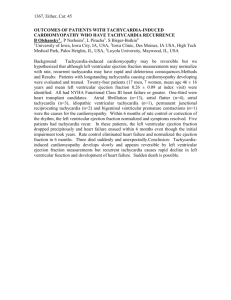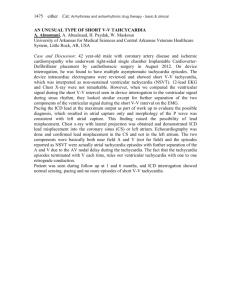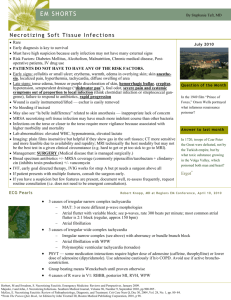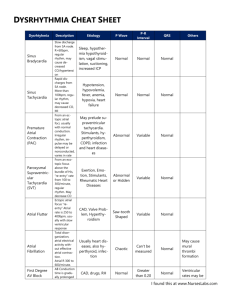Tachycardia-induced heart failure
advertisement
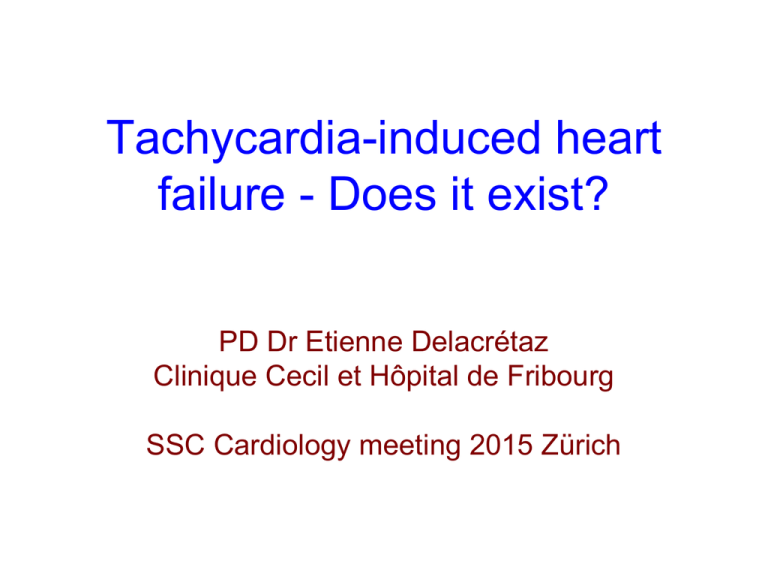
Tachycardia-induced heart failure - Does it exist? PD Dr Etienne Delacrétaz Clinique Cecil et Hôpital de Fribourg SSC Cardiology meeting 2015 Zürich Rapid atrial fibrillation is a common cause of heart failure Symptoms LIGHTHEADEDNESS SYNCOPE FATIGUE Thromboembolism & stroke PALPITATIONS DYSPNEA CHEST PAIN AF may also be asymptomatic Heart failure Hospitalisation Disability Death Gossage and Braxton Hicks Quaterly J of Medicin 1913 4 patients with AF, discussion: …. Heart failure model induced by rapid pacing Heart failure induced by rapid pacing The aim was to reproduce the human condition of tachycardia-induced cardiomyopathy, but it has been used to evaluate broader questions in CHF Atrial pacing at 330 beats/min induces symptoms and physical signs of CHF in the dog: - Biventricular failure with cardiomegaly, hypoperfusion, pulmonary congestion, cachexia and ascites - HF is reversible after cessation of pacing Whipple GH, Proc New Engl Cardiovasc Soc. 1961. TIC: Clinical vignette 72 y.o. patient, congestive heart failure, LVEF 20% Atrial flutter with 2:1 AV conduction LVEF normalized 2 months after electrical cardioversion Reversibility of TIC Catheter ablation of AF in congestive heart failure Shu, Haïssaguerre, NEJM 2004 Definition Tachycardia-induced cardiomyopathy Impairment of left ventricular systolic function secondary to chronic uncontrolled tachycardia, which is partially or completely reversible after normalization of heart rate (and/or rhythm irregularity) Arrhythmias associated with TIC Supraventricular causes Atrial tachycardia Atrial flutter Atrial fibrillation Atrioventricular nodal reentry tachycardia Atrioventricular tachycardia Permanent junctional reciprocating tachycardia Arrhythmia associated with TIC Repetitive monomorphic VT Arrhythmias associated with TIC Frequent VPBs Idiopathic VPBs • 70% originate from the RVOT • Multiple other origins -LVOT -valve annuli -epicardium -PA -aortic sinuses of Valsalva * -near the bundle of His -coronary sinus and cardiac veins 3D activation map of LVOT focus PVC burden and LV dysfunction : Cut off value? Patients with decreased LVEF had a higher mean PVC burden than their counterparts with normal LV function (29%–37% versus 8%–13%) lowest PVC burden resulting in cardiomyopathy was 10% Other risk factors male gender absence of symptoms persistence of PVCs throughout the day longer PVC duration presence of non-sustained ventricular tachycardia multiform PVCs RV PVCs Bogun F, Heart Rhythm 2007 Baman TS, Heart Rhythm 2010 Hasdemir C, J Cardiovasc Electrophysiol 2011 Arrhythmias associated with TIC Supraventricular causes Atrial tachycardia Atrial flutter Atrual fibrillation Atrioventricular nodal reentry tachycardia Atrioventricular tachycardia Permanent junctional reciprocating tachycardia Ventricular causes Premature ventricular complexes VT : Right ventricular outflow tachycardia Ventricular pacing at high rates (pacemaker mediated tach) Asynchrony: LBBB, chronic RV pacing Arrhythmia-induced cardiomyopathy Rapid heart rate Rapid Afib, prolonged or repetitive SVT / VT Asynchrony LBBB chronic RV pacing VPB/VT Myocardial dysfunction Irregular rhythm AF VPB Update of the definition Arrhythmia-induced cardiomyopathy Ventricular or atrial dysfunction secondary to rapid and/or asynchronous*/ irregular myocardial contraction, partially or completely reversible after treatment of the causative arrhythmia *PVCs or right apical ventricular pacing Not only cases without primary structural disease patients with ventricular dysfunction of another origin are also prone to develop TIC Pathophysiology of TIC: Rapid ventricular rates Simantirakis, Europace 2011 Time progression and recovery TIC develops within weeks, also depends on - Heart rate - Arrhythmia burden - Underlying heart disease - Unknown factors Recovery of symptoms and LV contractility is expected within 3 months after rhythm or rate control of the tachyarrhythmia Atrial TIC Atrial remodelling resulting from incessant tachycardia, « Afib begets Afib » The mechanisms contributing to atrial remodelling– atrial dilatation and systolic dysfunction—differ substantially from those for ventricular myocardium. Alterations of calcium handling, driven from downregulation or altered function of the L-type Ca(2+)channel and an increased Ca(2+) extrusion via the Na(+)/Ca(2+)-exchanger have been proposed as primary ionic changes. Schotten, Cardiovasc Research 2002 Treatment Pharmacological treatment rate control or rhythm control of AF anti-arrhythmic treatment of AT, SVT, VPBs Electrical cardioversion (AF/Aflu) Catheter ablation AF, AFlu, AT, SVT, VPB, VT Cardiac resynchronisation therapy Conclusion Tachycardia/arrhythmia -induced cardiomyopathy: - is a reversible cause of heart failure and dilated cardiomyopathy - should be considered in all patients with a dilated cardiomyopathy and who have tachycardia or atrial fibrillation with a fast ventricular rate - Abolishing tachycardia with drugs or catheter ablation often results in clinical improvement and ventricular function recovery

